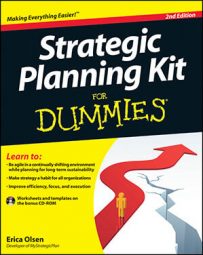Choosing which target markets to pursue in your strategic plan can be challenging. You may want to target all segments, especially those that are growing and appear very profitable, but resist the temptation. Most businesses can’t possibly serve all identified target markets (or at least not well). Try to choose between one and three new markets to target at any given time.
Additionally, you want to make sure that your company doesn’t enter into segments that you can’t support or don’t have the resources to provide excellent customer service. You want to focus your energies on the most attractive segments. I show you how to identify attractive markets and then evaluate them in the following sections.
If you identified only two or three new markets total, verify that you’ve identified the most attractive target markets. Use the following checklist to evaluate the attractiveness of each potential segment:
Competitors: Look at your competitor analysis. Are you better than the competition? Is the competition getting better or worse at meeting the needs of customers in this segment?
Company resources: Do you have the right strengths to compete in this segment? Do you have weaknesses that need to be improved and are they fixable? Review your company’s strengths and weaknesses. Look at the culture of your organization. Is it consistent with serving this segment?
Segment size: The sales potential of the segment, in terms of number of units of your product that can be sold or number of customers served, is important in making a segment attractive. Is it big enough to bother with? Remember, size is relative. What may be too small to one company may be huge to another. Evaluate where the segment is big enough based on your requirements.
Segment growth rate: To reduce the risk of losing money when entering a new market, find one that’s growing, not shrinking. Although this idea may seem obvious, many companies enter markets that are shrinking. Ideally, you should create a market strategy that allows you to serve a market for a good length of time, recouping marketing expenses and any product or service modifications.
Segment profitability: You need to know whether focusing on this customer group is feasible. A segment’s profitability is important in making a segment attractive. Knowing how profitable is profitable is subject only to your company’s requirements. You can estimate revenue for one year with a simple formula:
Number of customers @@ts average sale per customer @@ts number of sales per customer per year = revenue
To determine profit from the segment, subtract the estimated costs associated with producing the product or service and reaching the segment.
Segment accessibility: Identifying an attractive segment is possible, but there’s no cost effective way to reach it. An attractive segment requires that you can reach this group through clear communication channels. To reach the people in this group, you first have to find them. A good indicator of segment accessibility is how easy or hard it is to dig up information in your market research efforts.
Segment differentiation: Uniqueness is a characteristic of an attractive segment. Will this group respond to product and service offerings differently than other groups you’ve identified? If not, consider combining two segments. Segment differentiation tends to be obvious. You either see a clear difference or you don’t. But you may need to additionally research or test-market your product or promotional message to make sure.

